The Untold Story of Snoopy Tennis, Part 1
Tracing the origins of Snoopy Tennis, from idea to getting ready for release
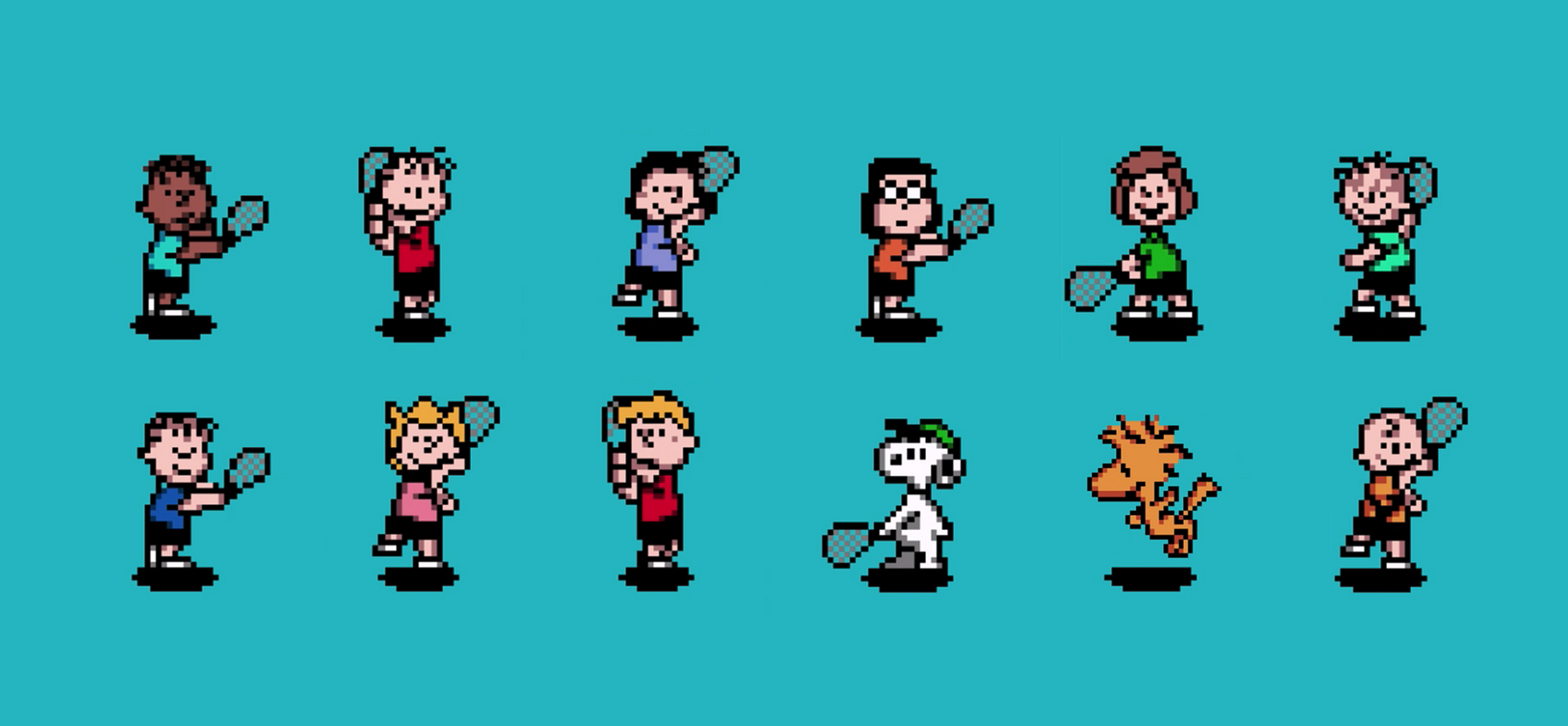
On the back pages of some classic video game manuals, there’s occasionally a list of credits for key members of the teams that worked on the project. At the end of the Snoopy Tennis Game Boy Color booklet, the publisher has a nice healthy list of Infogrames contributors, but there’s also a lonely logo for “Mermaid Studios” with a blank space underneath where the developer names should have been.
Internet searches return missing information about the developer. MobyGames credits are greyed out. GameSpot info is empty. GiantBomb leaves the developer name out completely. Wikipedia is barely more than a stub.
But Mario Tennis has a bunch of credit info. Ditto for Pokémon and Zelda – all games from around the same period of time. For an indie title in the early days of video game history, this might not be strange, but here was a major publisher with a high-profile license, releasing Snoopy Tennis into an environment in which the internet had already solidified a gaming community rich with information. But what about developer Mermaid Studios? Who were these secret devs that slipped past the high gate of entry and delivered a lob shot over the heads of the industry giants?
Google searches reveal an abandoned landing page for Mermaid Studios here, with the enigmatic subtitle “Everything you’ve heard is true.” There’s no contact button and the DNS registry is masked. Wandering around LinkedIn shows there’s a Mermaid Studios in Berlin, but it’s for IT services and wasn’t founded until 2017. Deeper in, there’s an unclaimed logistics and supply chain company by the same name in Irvine, California but the website links out to a kid's art studio in Pennsylvania. It’s all quite odd.
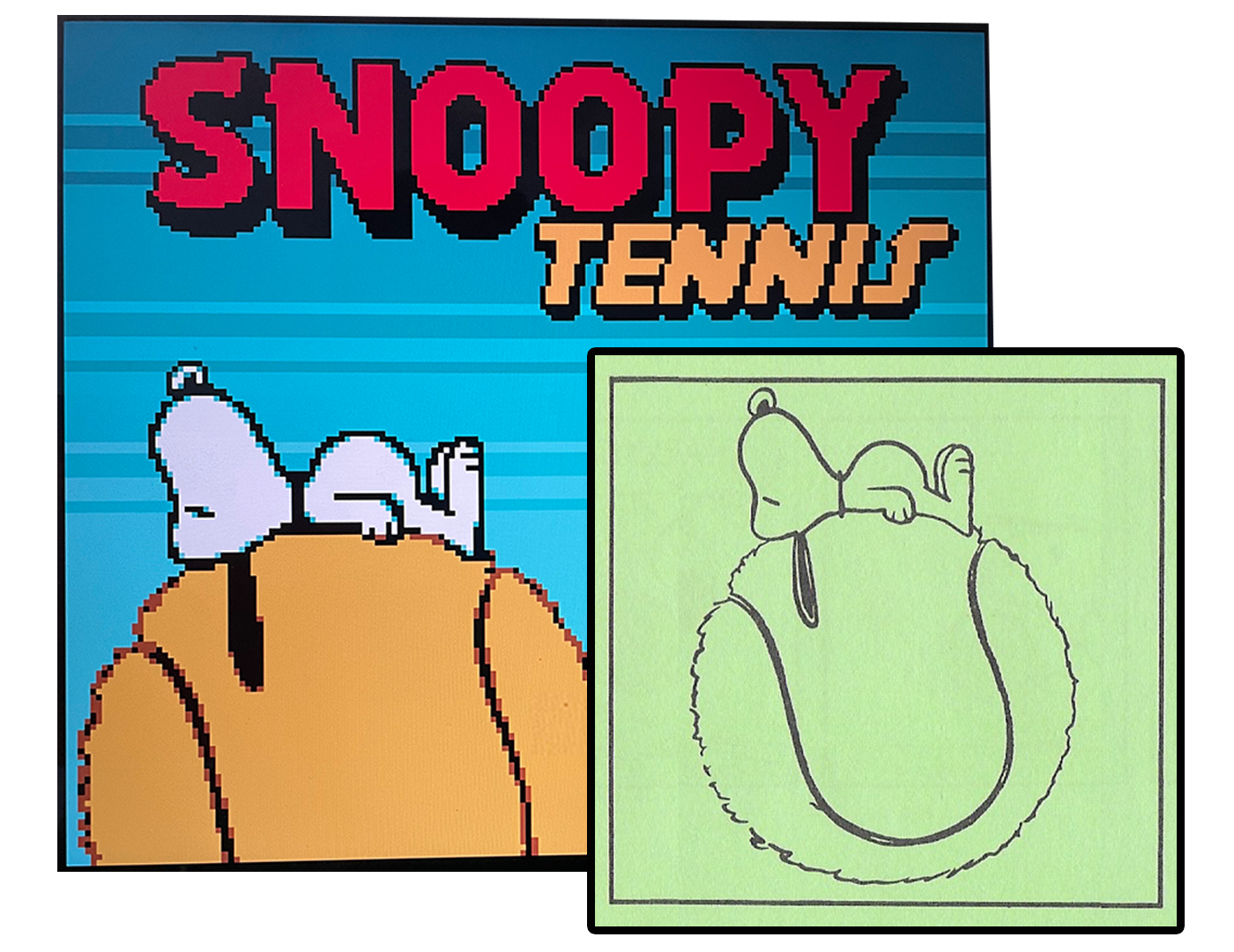
Adding industry keywords to the search like “interactive” and “game design” produce a few links that list company incorporation details for Mermaid Studios Interactive registered in 2000 in the UK, with two potential leads — Brian Lau Tomczyk and Martin Jensen, listed as director and secretary respectively. Mr. Tomczyk doesn’t seem to have a profile on LinkedIn…but Mr. Jensen’s profile, down there below the fold of previous experience, between stints at Core Design and Shiny Entertainment, has “Mermaid Studios Ltd — Technical Director” listed. The company name links out to that same random logistics company/kid's art studio, but the timeframe checks out – meaning they might potentially have worked on Snoopy Tennis.
After sending through a shot-in-the-dark contact message, this response came back a day later:
MARTIN: Snoopy Tennis has a funny story behind it.
Then Martin shares this bit of trivia:
MARTIN: The game was created by 2 people — Brian and Me.
Two people made an entire Game Boy Color game with licensed IP for a major publisher. How in the world? Martin was generous enough to track down and loop in Brian Lau Tomczyk and from there, the story formally unfolds.
MARTIN: At the time we were working for a games company called Core Design Ltd. based in the UK. We were kind of fed up with the job and decided to create our own game.
BRIAN: A two-man team is still a little on the “light” side even for a Game Boy game, but Martin is basically the Chuck Norris of programming, and I’m not completely useless at doing graphics. So we set out to produce the greatest tennis game ever made.

Introducing the Key Players
The Armadillo. Instead of naming their company after a French slang word for a male body part, founder Bruno Bonnell settled on the Armadillo as a symbol for their Société Anonyme company Informatique Programmes, condensed to Infogrames. (Société Anonyme or "SA" is the French equivalent of an incorporation). At the turn of the century, having completed the acquisitions of a wave of other game companies, they were also in the midst of a licensing melee. The company announced partnerships with everything from Looney Tunes to La Femme Nikita — actively hanging their future growth on licensed IP to drive market awareness and sales. Tucked in amongst the deals made was an agreement for the rights to release Peanuts-related video game content.
The Beagle. One of the most iconic cartoon dogs of all time, Snoopy was big into tennis. Charlie Brown might be known for football, but Snoopy’s dreams were set on Wimbledon. Turns out creator Charles Schulz was quite the athlete, and became a huge fan of tennis in the ‘70s, working the sport into his Peanuts comics and even hosting his own real-life tournament, “The Snoopy Cup”. Like the worldwide popularity of tennis, the universally accessible minimalist cartoon Beagle became a smash hit — syndicated and licensed all over the world by United Media. In Japan, Snoopy’s popularity dwarfs all of the other characters in Peanuts to the point where Charlie Brown is borderline unknown. The love runs so deep that Snoopy has an entire museum of his own in Tokyo. Professor Stephen J. Lind of Washington and Lee University attributes the cultural affinity for Snoopy to the Kawaii levels of cuteness the country seeks as a counterbalance to their conservative work appearance pressures. With the worldwide scope of video games, the fact that the title is Snoopy Tennis instead of Charlie Brown Tennis or Peanuts Tennis is likely no accident.
The Plumber. Nintendo was one of the first to jump on the game licensing bandwagon with United Media, the controller of the Peanuts franchise. Even before the iconic plumbers Mario and Luigi came along in 1983, the former playing card maker released the precursor to modern handhelds with the identically named Snoopy Tennis for the “Game & Watch” portable in 1982. The play mechanics found Snoopy swatting faster and faster tennis balls back to Charlie Brown and Lucy from the tree branches — art that was hard-printed onto the screen of the device. The device was massively successful with over a million units estimated to have been sold.
The Mermaid. We all know the Disney version of a fabled half-fish of the sea choosing to give up life as she knows it for the chance at love and two feet, but the darker original story is an 1800s Danish fairy tale. There’s a century-old statue of “The Little Mermaid” on the shore of Copenhagen in Denmark commemorating the legend, which is where both Brian and Martin are from. Brian adds a bit of color to the name:
BRIAN: I can’t even remember how many stupid ideas we went through, but nothing really clicked. Martin wanted something with a Danish element or reference, and he eventually came up with the Mermaid part, inspired by The Little Mermaid, one of the few things Denmark is famous for. I then suggested the “Studios” part, and considering how long it had taken us to get to Mermaid, it was easy to sell Martin on it. It really wasn’t our best creative work.
Taking a Break From Tomb Raiding
It’s October 1998. At the Core Design quad in Derby (literally a house!), the mood was positively gloomy. The relentless grind Eidos Studio imposed on Core for perpetual yearly Tomb Raider releases left Brian and Martin looking for distractions. They had been working closely on the PlayStation title Ninja: Shadow Of Darkness as Designer and Lead Programmer, and the Game Boy Color had just launched.
BRIAN: We had always liked the idea of handheld games, so Game Boy with its relatively cheap 3rd party development kits and decent software emulators made it the ideal platform. I was a pretty big tennis fan, and Martin had always enjoyed keeping the universe safe from evil aliens.
MARTIN: Because we had to do the game in our spare time we had to choose a game that did not require too much work.
BRIAN: Since we were just a two-man team, and our ideas for a space shooter were quite ambitious, a tennis game seemed like a less daunting choice for our first project.
While Martin busied himself in his early days on machines like the ZX81 and ZX Spectrum, Brian’s teenage years in Denmark were spent partly in front of the PC and partly on the tennis court — his dad got him a racket to get him away from the computer. Initial hatred of the sport's difficulty curve turned to love as his skills improved over time.
BRIAN: Tennis is not like badminton where you can just easily whack the ball back and forth. It’s very difficult to pick up. If you don’t know how to hit the ball correctly, you’re either going to send in into orbit or into the net. Having played most of the tennis games at the time, there were a few like Super Tennis on SNES and Tennis on the classic Game Boy that had elements I liked from the real sport, but many others were basically just Pong with rackets.
In 1995, Brian and Martin had bootstrapped a space shooter game demo in college for the Amiga that got them both job offers from Core. Making the leap from Denmark to the UK together, the two still conveniently lived in the same building in the town of Derby, about 130 miles north and a little west of London. Away from the Core Design offices, the duo from Denmark got to work on the game with Brian designing the art and Martin programming the code. Fueled by vinegar-soaked french fries from FatCat pub and Brian’s homemade bread, they talked over the phone, hoofing up the stairs to share Zip disks, and eventually setting up a local FTP server to save the trips.
MARTIN: Normally you would just program (Game Boy Games) using a Z80 Assembler but I found an open-source C-Compiler for it and used that instead. It produced fast enough code and helped us reduce the development time.
The Z80 Assembly language is a style of machine code that’s a half step up from typing a string of 1’s and 0’s into the console to interface with the computer processor. Really fast to run, but really inscrutable for humans to read… “Load A from DE then Store A into HL then Increment DE then Increment HL then Decrement BC…” The C programming language used in the open-source C-Compiler is more friendly to translate and understand.
MARTIN: I did not have an official Nintendo Dev Kit or hardware manual so I had to do a bit of hacking around to get things working. Whenever I wanted to see the game running on a real Game Boy I had to use a flash card copier. But most of the time I just used a Game Boy emulator on the PC. I think we spent about 8–12 months getting the game to a state where we could start to shop it around to various publishers. At that point, it looked nothing like Snoopy Tennis.
The original iteration of the game was called Tennis Champ (with Core Design co-workers used as inspiration for some of the characters' faces). With a working build, Brian began pitching game publishers, accompanied by a demo trailer with a title card that included a text quote from an 18th century Earl of Derby, Edward Bulwer-Lytton: “Talent Can…Genius Must.”
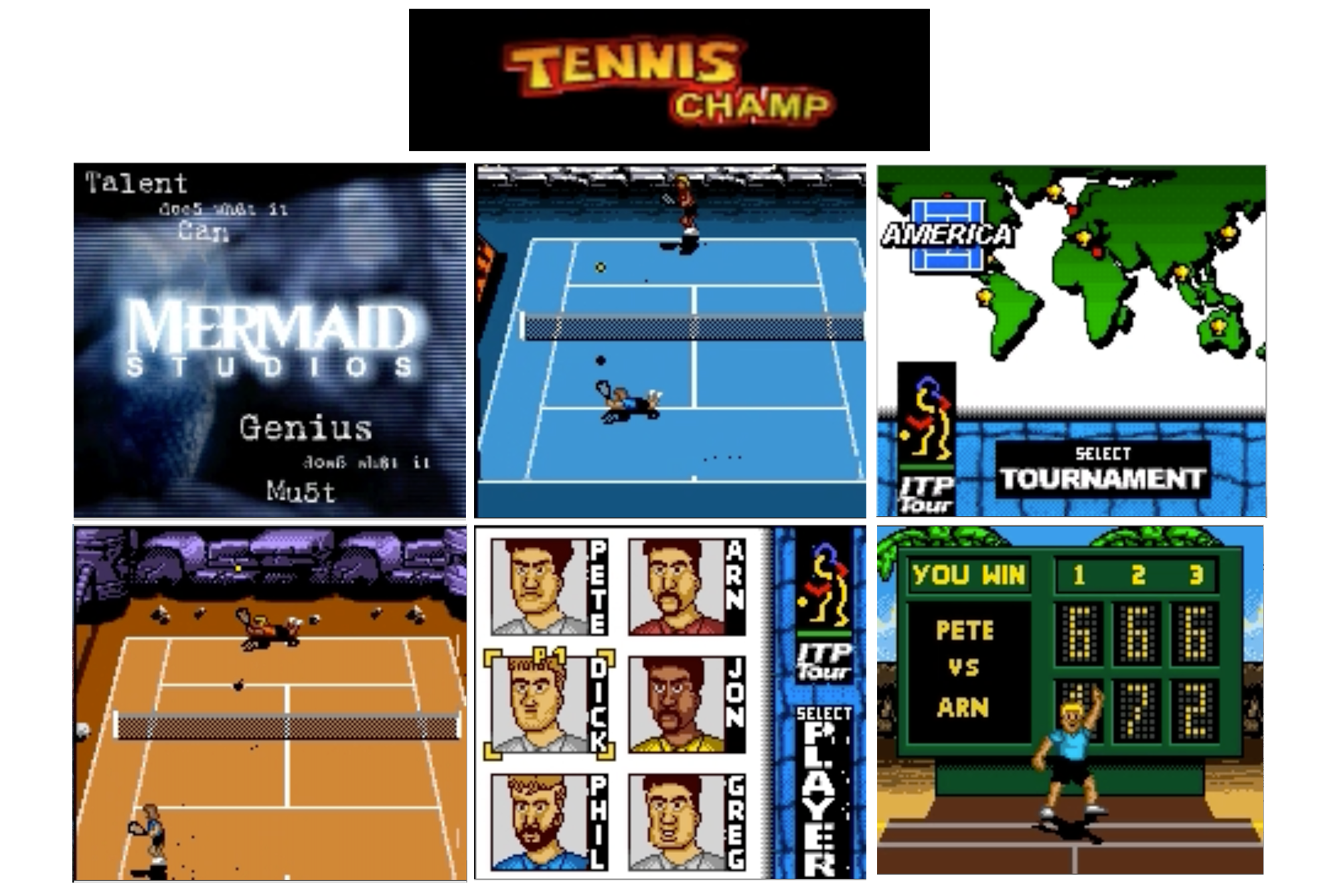
Unfortunately with the Game Boy Advance console release looming on the horizon and the next-gen Xbox, PS2, and GameCube development efforts subsuming resources, they found that old-school Game Boy publishing interest was starting to wane.
BRIAN: We initially contacted 5 or 6 publishers. The response was a bit of a mixed bag. A few were very complimentary about the demo but said they were getting out of the Game Boy market, and a couple of others didn’t reply at all. Only one came back with what sounded like actual interest. We went back and forth with them for a little while, but the talks eventually just died out.
Meanwhile, around the time of Charles Schulz's death, Infogrames had entered into licensing negotiations with United Media and in June of 2000, the spend-happy armadillo entered the picture looking to quickly capitalize on their new IP deal. Having failed to acquire Eidos and Core over the summer, Infogrames found the next nearest thing: signing two of the folks that worked there for a project.
MARTIN: (Infogrames) had just acquired the Peanuts license and needed a title for it. Perfect match!
BRIAN: They were a little bit concerned about us only being two people, though, but I gave them the Chuck Norris spiel, and we were off to the races.
Brian quit his job at Core first and went all-in with Mermaid Studios, but Martin held out until there was an actual signed contract before jumping ship from his day job.
BRIAN: Infogrames got to work on the first draft of the contract, and everything seemed to be going smoothly. I had once heard someone in a movie say you should never accept someone’s first offer, so we asked for a bigger royalty cut if only to make it seem like we knew what we were doing. But then the contract was suddenly delayed, and soon after our contact wasn’t replying to emails or phone calls. After a few weeks of silence, we figured this wasn’t a good sign, and that the deal was probably dead.
While waiting, Martin finished up work on Tomb Raider: The Last Revelation and got a good glimpse of work down the hall by Core Design on the Tomb Raider release for the Game Boy Color (Published by THQ).
BRIAN: Nearly a month later, we got an email from a new guy at Infogrames named Christophe Gomez. He informed us that he had taken over managing the office, that the guy we had previously dealt with was no longer with the company, and that he wasn’t sure which projects he could greenlight, but that he would get back to us in a week or so. So, yeah, definitely dead. But then we got a super enthusiastic email from him just a few hours later saying he thought the game looked amazing, and they wanted to move on it immediately as per the original deal. Aaaand we were back in the race.
With a signed contract, royalty deal, and a nice advance in hand, Martin quit Core Design too, continuing on the quest to be added to the ledger of tiny development teams pulling off extraordinary feats. Mermaid Studios Interactive Limited was officially registered as a company on Tuesday, August 8th, 2000 under business category 62011: “Ready-made interactive leisure and entertainment software development” with Brian named as Director and Martin as Secretary.
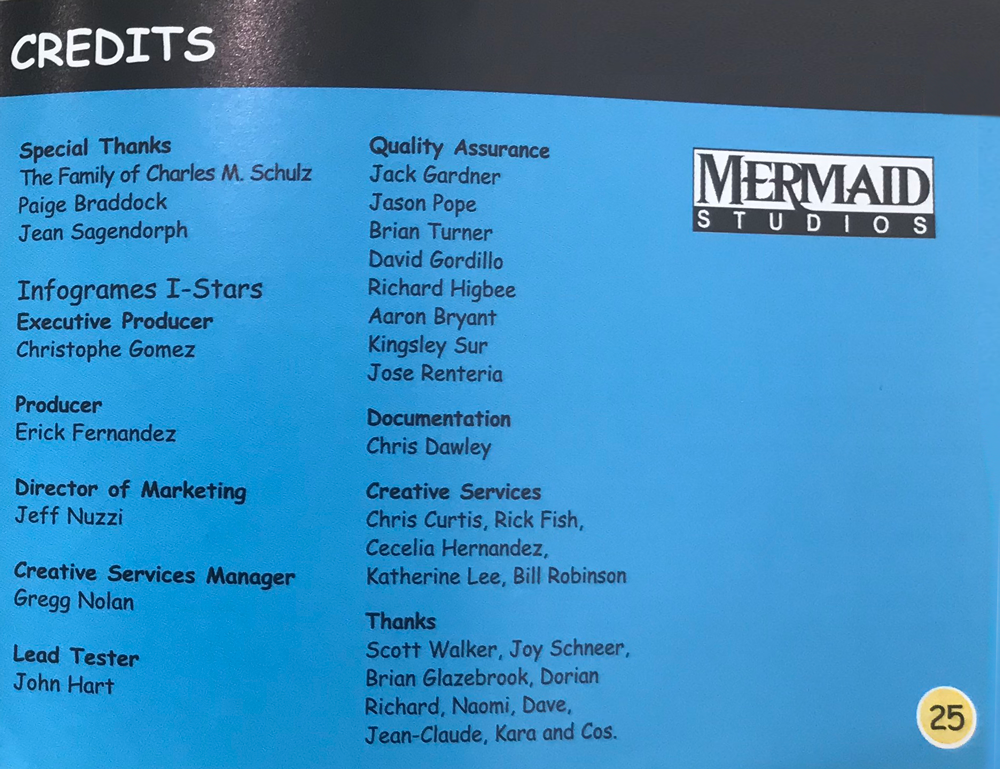
Snoopy Goes to Hollywood
At this point, Infogrames was a sprawling operation across the world. The Accolade offices in San Jose were fielding games. In Europe there were the old Eden Studios offices in France, known collectively as the “Lyon House”, the old Atari offices in the UK called the “Landmark House”, and, also in the UK, the old Gremlin Studios space known as the “Sheffield House”. The former Krome Studios offices in Australia were known as “Melbourne House”, and the armadillo was about to take over the defunct Digital Entertainment Networks offices in Santa Monica, plus their headquarters on 5th Avenue in New York and their joint venture with Hudson Soft location in Japan. These joined their myriad other stateside offices: the former GT Interactive corporate headquarters in Cupertino, the Humongous offices in Washington, the Hasbro Interactive location in Massachusetts, and the old WizardWorks and MacSoft location in Minnesota.
Snoopy Tennis was not fielded at any of those places, instead being managed out of the tiny Warner Center Office Park location in Woodland Hills, California. Gregg Nolan who helped produce marketing for the game provides some context:
GREGG: At the time the Woodland Hills office was very small, consisting mostly of dev resources and some senior staff. That office was spawned really to give Infogrames a “Hollywood” presence wanting to contract a lot more studio licenses by being in that area as opposed to up north.
Snoopy Tennis would be one of the last games published from that location before all of the west coast hubs were funneled into the new Santa Monica headquarters amongst the ruins of DEN. The scrappy little team in Southern California had anointed themselves the “I-STARS” (or “I-HEROES” in the European manual) and Executive Producer Christophe Gomez tasked Erick Fernandez to facilitate the remaining development process for the game.
ERICK: Snoopy Tennis was one of my favorites because of how fun it was. My job as producer was to work with all the main parties involved but specifically Mermaid Studios and the Schulz team externally. At the beginning of our relationship, I actually went up to Santa Rosa, California to have a meeting with the (Shulz) family and present the different titles we were working on.
On the beagle side, Paige Braddock, Creative Director of Schulz Creative Associates in Santa Rosa, and Jean Sagendorph, Worldwide Director of Licensing and Brand Marketing at United Media in New York kept oversight of the details of the partnership. Thousands of miles away, Brian and Martin continued the process of adapting the existing Tennis Champ game to feature Snoopy and the gang with a toolkit of supplied assets from the Peanuts creative team.
ERICK: From what I can remember there was a lot of feedback for some of the titles, like the PlayStation game we were working on they wanted a lot of changes (the canceled Snoopy Mania and Snoopy Detective), but for Snoopy Tennis I remember them liking it right away and only requesting a few small changes.
BRIAN: They did ask to have the title of the “Sudden Death” mode changed to not include the word “Death”, so that became “Sudden Win”. Similarly, we had to change a skull icon and a few other minor tweaks like that.
BRIAN: We also expected some pushback on the size of Woodstock. He’s obviously a tiny bird, and would have been difficult to implement at the correct size. A small, yellow sprite like that would have been difficult to distinguish from the ball, never mind how tricky it would have been to have him wield a normal-sized racket. So the decision was made to make him as big as the other characters. I’m not sure it was the best idea, as it does kind of look like Big Bird walked onto the wrong set, but United Media was fine with this compromise.
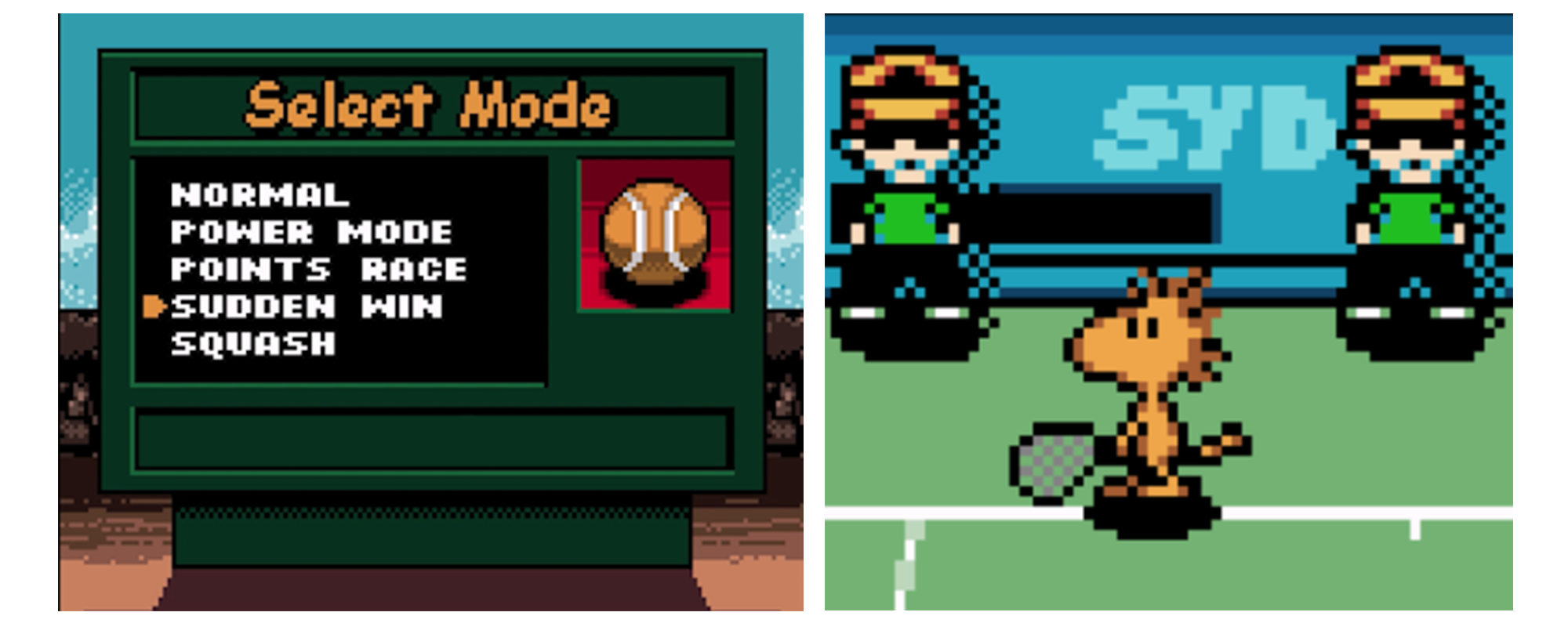
ERICK: The one thing I remember asking them was to have a more gradual progression to the game because I remember the AI being really tough at the start.
Indeed. Snoopy Tennis on hard mode is insanely difficult, rivaling the rage-quit-inducing Turbo Tunnel in Battletoads, Super Star Wars, or Mike Tyson’s Punch-Out! in its requirement of supreme flawless concentration, timing, and focus. A continuous play-through of the Championship rounds can take upwards of two straight hours. On SpeedRun, “Peanutfan22” was the lone record-holder for winning on easy and medium difficulty with Linus, but in twenty years no one had posted a winning session on hard mode.
Martin is unaware of anyone other than Brian having won the championship straight through with the Snoopy character. It’s as close as mere mortals can get to experiencing what it must be like to go up against Federer or Sampras or a giant yellow bird at Wimbledon and get your keister handed to you for three straight sets. Although as of 7/8/21, there is a hard mode winner using the ReRun character, but still no Snoopy, implying folks are using known cheat codes to unlock the most powerful character for playthroughs.
BRIAN: We wanted players to be able to use real tennis tactics. We created a control system where position and timing were important to pulling off the shots you wanted. For instance, other than controlling direction and depth, we also had the ability to control the height of the ball over the net. So if an aggressive opponent is attacking from the net, either a well-executed low slice or a dipping topspin shot means he will either have to have great timing to be able to play a winning shot, or he will have to go for a safer volley to avoid making an error, which would then put him on the defensive.
We can also use the slice as a classic chip’n-charge approach shot to get to the net, which again will require good timing from the opponent to deal with. It was important to us that the controls were created to have a certain amount of depth, but without being too complicated. That kind of depth to the shot selection and execution was something that really differentiated our game from a lot of contemporary tennis games.
Unfortunately, with the time lost in awaiting the formal contract and a strange shortage of physical cartridges in Japan, plans to complete the game by the holiday release window had to be abandoned.
BRIAN: Getting the number of games produced we needed wouldn’t be possible, even if we could get the game finished and approved by Nintendo by mid-September, which was the cutoff for a Christmas release. There was also a Mario Tennis game coming out, so our release was pushed further back.
Development plowed ahead in the looming shadow of Mario Tennis, in addition to the fallout from the dotcom bubble, all the Y2K nonsense, the release of the PlayStation 2, and Infogrames completing the acquisition of Hasbro Interactive and Atari. During this time – the testing and quality assurance phase of the game’s development – Erick would relay bug report communications between the San Jose QA team and Brian and Martin in the UK.
MARTIN: With regards to quality assurance: we first did internal testing, then we sent it off to Infogrames for testing. The way it worked was that we produced a “ROM” (read-only-memory) image. It is a bit like a zip file without compression. This image is ready to be “flashed” directly onto a cartridge. Infogrames had their own ROM cartridge burners so we just sent the file digitally. The part with the sending of the ROM is a bit hazy, I think we FTP’d it.
Sourcing information on specifics about the QA game testing team has proven elusive. Lead tester John didn’t reply to inquiries. Brian Turner doesn’t remember. David, Jack, Jason, Jose, and Richard don’t seem to exist. Kingsley might have passed. Was there a darkened room in California where game testers would come to play demo versions on real devices? Were they sent password-protected emulator software? Were they tasked with trying out different parts of the game?
MARTIN: The bug cycle repeated until only very minor known issues were left and we/they felt that we would have a good chance of passing the submission to Nintendo for final approval.
Brian and Martin were finally ready to put their creation in the hands of Nintendo's notoriously stingy QA department. Would it be approved? Would Nintendo like it? Only Part 2 holds those answers and the rest of Snoopy's story!
